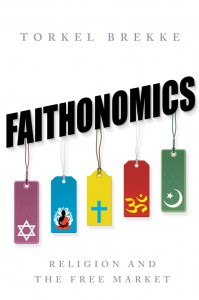Book Review: Faithonomics An Economic Case for Jefferson’s Wall

Torkel Brekke’s Faithonomics: Religion and the Free Market is a solid attempt to frame the role religion plays in societies around the world through the language of economics. The attempt itself is laudable, if only to encourage the publication of more analyses of faith through economic lenses written for a general audience, but Brekke’s book is also worth the read.
Brekke (deputy director and research professor at the Peace Research Institute Oslo) starts with the premise that regardless of whether religion has a positive or a negative impact on society, the government should not be involved in any way with the supply of religion. In other words, church and state should be strictly separate, providing a conclusion that humanists can stand behind—not just on moral grounds, but also because special privileges lead to economic inefficiency and misaligned incentives. “From the point of view of government,” he writes, “what is the difference between a school arguing that it will not accept people of a certain race and a religious organization saying it will not consider women for positions of leadership?” The book emphasizes the importance of religious liberty, and also demonstrates, to the delight of those who believe religion is good for society, that there is evidently higher consumption (aka practice) of religion where there is a diverse set of beliefs (and nonbelief) to “choose” from.
We know, and Brekke knows, that “choice” is illusory—as religion, even defined as a product or service, has complex properties: religions are not perfectly substitutable goods, and may or may not offer the same services that make them desirable to the consumer. In other words, the intangible elements of belief, which are not easily qualified and categorized, make it unlikely that a person will hop from one major religion to another. More interestingly, there is often no hard marker of when an ideology is cultural or when it is a religion, with all the privileges that come with esteeming the value of the latter.
For example, in some countries a practice might be considered cultural, but upon migration to another country where it becomes a minority lifestance, it may be defined as a religion. He uses this as a case of reification, where the process of identifying a set of cultural beliefs and rituals, or the creating of labels used in measuring faith identity and religiosity, brings about the existence of a thing—in this case, the thing is religion.
One example Brekke offers is that of Confucianism:
Two important “religions” in Korea do not fit the idea of what religions should look like. These are Confucianism and shamanism. Confucianism exerts powerful influence in Korean culture and it is in the government census about religion, but very few people say they are Confucian if asked. Confucianism is simply not seen as a religious identity. In this respect, Confucianism in Korea is seen in a similar way to Confucianism in China—it is seldom perceived to be a religion in its country of origin, but often “becomes” a religion when it settles in other countries.
Brekke doesn’t attempt to find precision or solidify the bounds of what constitutes a religion, recognizing the challenge of defining fluid and changing bounds, although he does consider why an individual may choose to migrate to a different sect of the same major religion, which may be more substitutable. Instead he leaves this question up to philosophers and sociologists.
Indeed, the merit of this book lies in its ability to pose big questions—and many of them—but not in its ability to answer them, nor would I hold this work responsible for answering those questions. While Brekke brings up what seems to be a weighty question of whether religion should be considered a public good—which by definition must be both non-rivalrous (everyone can enjoy it without taking from the enjoyment of another) and non-excludable (if one person benefits, everyone benefits from it)—he quickly resolves it by explaining how religion isn’t non-excludable in specific contexts. In some theocracies or during certain time periods, to not buy into religion in the form of church taxes has meant an individual is excluded from life-cycle rituals considered sacred, and more importantly, eternal salvation.
Admittedly, Brekke’s aim is not to debate whether religions are overwhelmingly a benefit or cost to society, but instead to simply scrutinize major religions (and atheism) and make observations about interactions between a religion and the state, and the incentives created in these systems, something which he succeeds at doing, to some extent. Yet a more systematic look at the various properties of religion might help explain where demand for particular religions come from (and how demand fluctuates over time)—which would help determine what reasonable comparisons of people’s actual choices might be.
But my expectations were perhaps to read a different book—and too high for one volume of 267 pages, when a treatment of religion via economics could produce an entire library of work. The power of economic analysis lies in its ability to represent reality and the insights it reveals through making visible patterns of behavior, which means that insightful economic analysis, to some extent, is dependent on the wisdom of the author. The reality of religions’ effects in different countries cannot be best modeled when it is abstracted and detached from the philosophical and psychological questions about the practicing of religion. I will say the oversimplification was perhaps inescapable for a work that aimed to accomplish so much. Regardless, Brekke’s ambitious Faithonomics is a scan of a broad variety of topics that will interest anyone seeking new ways of thinking about the interactions of society and faith.
